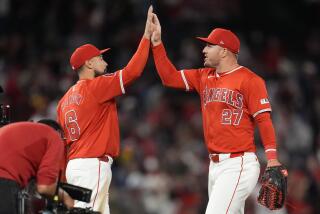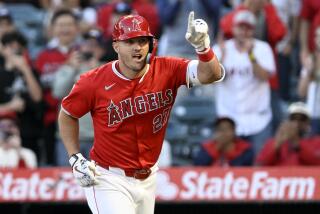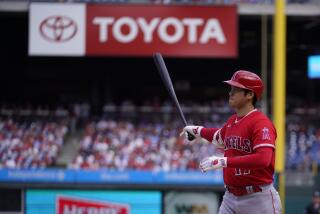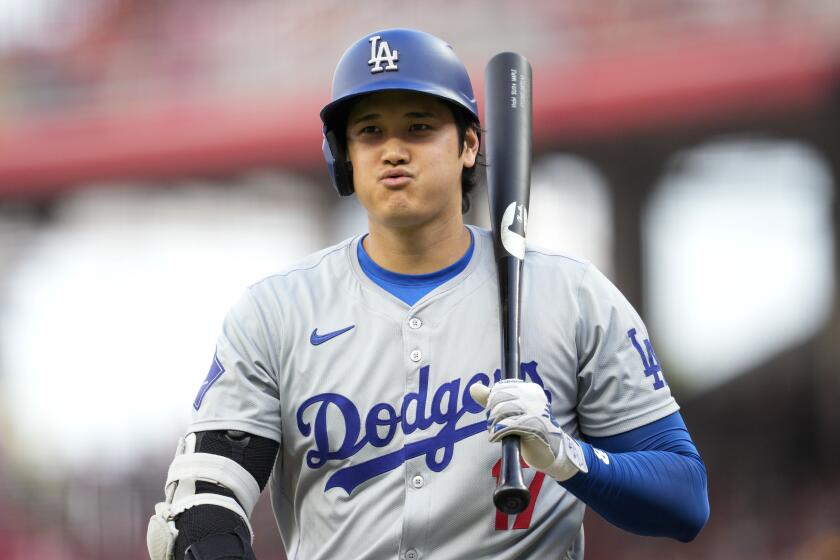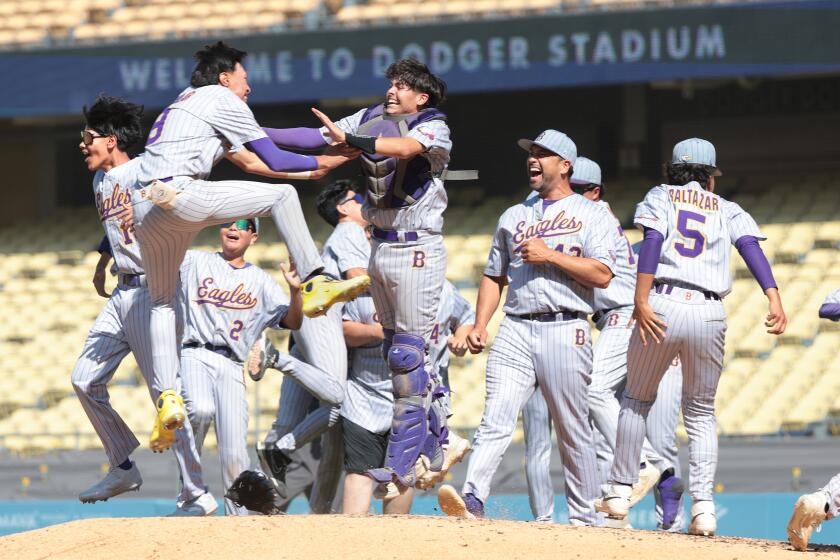Something is off with major league offenses
Jorge Posada and his big-league worst .152 batting average drop to the bottom of the lineup, and the Yankees catcher, humiliated, contemplates retirement.
Albert Pujols, who hit more home runs in his first 10 big-league seasons than any player in history, goes a month without one.
And more than a quarter of the way into this season, All-Stars Vernon Wells, Carl Crawford, Adam Dunn, Dan Uggla and Alex Rios have batting averages below the Mendoza line, .200, the boundary separating hitters who are merely struggling from those who are genuinely awful.
What in the name of Honus Wagner is going on here?
“I have no idea,” Angels coach Mike Butcher said. “I wish it would last longer.”
Did we mention that Butcher is a pitching coach?
“It goes in cycles,” Butcher continued. “I don’t think there’s any rhyme or reason for it.”
But there is an undeniable pattern developing.
If you liked last summer’s Year of the Pitcher, you’re probably going to love the sequel. For the second straight season, offense is down — way down — with teams hitting just .251, the worst mark this late in a season since 1972. Teams are averaging less than 4.2 runs a game, and on-base percentage and slugging percentage are at their lowest points in two decades.
Earlier this month, Detroit’s Justin Verlander and Minnesota’s Francisco Liriano threw no-hitters on consecutive days — this not too many seasons removed from a 21/2 -year, 6,000-game span without a no-hitter. In the last 12 months, there have been eight no-hitters, including two perfect games.
Mario Mendoza’s name has for years been invoked to convey offensive ineptitude, but today the shortstop with a .215 lifetime batting average might hit in the middle of some lineups.
Offense is also down at the college level, where halfway through the season, Division I teams were hitting half as many homers, scoring 1.5 fewer runs and batting more than 20 points lower than they did last season.
But in college the reason is clear: New regulations made aluminum bats perform more like wood ones.
Explaining the drop-off at the big-league level isn’t so easy, but there are theories.
“Hitting is much harder today than it was in the past,” said Angels outfielder Torii Hunter, who, with a .218 average, four homers and 19 runs batted in through 45 games, is on pace for career lows in nearly every significant offensive category.
“The game has definitely changed. The strike zone has changed; everything’s changed,” he said. “You can’t [put] a finger on one thing. Look at how many pitches there are now. Scouting reports. You’ve got hot-cold zones. You’ve got everything.”
And there’s also what you don’t have: rampant use of performance-enhancing drugs. Many observers believe that has had more of an impact on declining offenses than wider strike zones, the introduction of different pitches and better scouting reports.
Lengthy suspensions for the use of performance-enhancing substances went into effect before the 2006 season, just about the time baseball’s offensive numbers began their fall. In the five seasons before that, a player finished with at least 45 homers 26 times — including Barry Bonds’ single-season record of 73 in 2001.
But in the five years since, the 45-homer mark has been reached only 14 times. And three seasons ago, the Tigers’ Miguel Cabrera led the American League with just 37 homers, the lowest number to win the league’s home run crown in nearly 20 years.
Hunter dismisses drug testing as a factor.
“Steroids are out of the game, but that has nothing to do with it,” he said. “More pitchers probably used them than hitters. So if it was that, then the pitching would be down.”
Hunter isn’t alone in his thinking. Four years ago, at the start of the offensive decline, University of Nebraska sports historians Benjamin G. Rader and Kenneth J. Winkle published a study that found the change in the strike zone was the strongest factor in the downturn of offensive statistics.
Some managers have another theory. They say pitching has simply gotten better, and, of course, the numbers back them up.
The overall earned-run average in the American League is 3.85 — more than a run lower than it was 11 years ago. And the big-league staff average of 3.80 this spring would have led the majors in 2000, when no team had an ERA below 4.05.
Strikeouts are also way up — to an average of more than 14 a game between teams — and walks are down.
Angels Manager Mike Scioscia knows the numbers and knows what he sees in a given game.
“The statistics might be enough of a sample to make a case,” he said, “but there’s no doubt from a scouting perspective there are a tremendous amount of young arms that are coming into the major leagues. And arms coming of age.”
Indeed, since 2006 an unprecedented number of talented young starting pitchers have flooded the majors, including Tim Lincecum, Jered Weaver, Trevor Cahill, David Price, Clayton Kershaw, Jaime Garcia and Jon Lester. Of that group, only two — Weaver and Lester — are older than 26.
“Right now, the pitchers have the hitters beat,” Texas Manager Ron Washington said. “I wouldn’t say the whole league is full of great pitchers. [But] the whole league has some good pitching in it.
“It’s like anything else: Some stuff sinks and some stuff rises.”
Butcher, the Angels pitching coach, notes that such trends usually run in cycles. So as much as he is enjoying the Year of the Pitcher II, he doesn’t expect it to last.
“To me, it all evens out,” Butcher said. “Two years ago, I remember being in Cleveland in late August and our whole lineup was hitting over .300.”
More to Read
Get our high school sports newsletter
Prep Rally is devoted to the SoCal high school sports experience, bringing you scores, stories and a behind-the-scenes look at what makes prep sports so popular.
You may occasionally receive promotional content from the Los Angeles Times.
